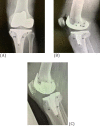Incidence of Radiolucent Lines after Cemented Total Knee Arthroplasty
- PMID: 35291250
- PMCID: PMC8889420
- DOI: 10.22038/ABJS.2021.54610.2723
Incidence of Radiolucent Lines after Cemented Total Knee Arthroplasty
Abstract
Background: Cemented Total Knee Arthroplasty (TKA) provides excellent long-term survival rates and functional results, however, radiolucent lines (RLLs) often appear during early post-operative follow-up and their incidence and clinical significance are unknown. The primary aim was to establish the incidence, location, frequency, and time taken for RLLs to appear within the first year after a primary cemented TKA with an anatomic tibial baseplate (Smith and Nephew, LEGION Total Knee System).
Methods: This was a retrospective analysis of 135 primary cemented TKA in 131 patients over three years. We compared demographics, serial radiographs, and early clinical and functional outcomes.
Results: There were 65 TKAs (48%) in 62 patients who had RLLs within the first year post-operatively. Most were females (58.8%). Mean age was 68.3 ± 7.9 years. There were 88 RLLs, with the most and second commonest location at the medial tibial baseplate (38%) and anterior femoral flange (23%). 89% were in the bone-cement interface. The largest average length of RLLs were at the anterior flange of the femoral component (1.98 ± 1.33 mm). The average time to development was 6.5 ± 4.1 months. None of these patients had infections nor required revision. Patients with RLLs did not do worse in functional and clinical scoring at 1-year.
Conclusion: There was a 48% incidence of physiological RLLs after cemented TKA, with the highest occurrence at the medial tibial baseplate at 38%. These radiolucent lines did not affect early post-operative clinical and functional outcomes of patients.
Keywords: Cemented; Radiolucency; Total Knee Arthroplasty; Total Knee Replacement.
Figures
Similar articles
-
Radiolucent lines and revision risk in total knee arthroplasty using the conventional versus the Attune S+ tibial baseplate.Bone Joint J. 2024 Nov 1;106-B(11):1240-1248. doi: 10.1302/0301-620X.106B11.BJJ-2024-0084.R3. Bone Joint J. 2024. PMID: 39481434
-
The natural history of radiolucencies following cemented unicompartmental knee arthroplasty at 7 years.Knee. 2022 Dec;39:203-208. doi: 10.1016/j.knee.2022.09.008. Epub 2022 Oct 7. Knee. 2022. PMID: 36215922
-
High rate of radiolucent lines following the cemented original design of the ATTUNE total knee arthroplasty.Bone Joint J. 2023 Jun 1;105-B(6):610-621. doi: 10.1302/0301-620X.105B6.BJJ-2022-0675.R1. Bone Joint J. 2023. PMID: 37259548
-
Ten-Year Follow-Up of High-Flexion Versus Conventional Total Knee Arthroplasty: A Matched-Control Study.J Arthroplasty. 2021 Aug;36(8):2795-2800. doi: 10.1016/j.arth.2021.03.017. Epub 2021 Mar 6. J Arthroplasty. 2021. PMID: 33810919 Review.
-
No difference between cemented and cementless total knee arthroplasty in young patients: a review of the evidence.Knee Surg Sports Traumatol Arthrosc. 2017 Jun;25(6):1749-1756. doi: 10.1007/s00167-017-4519-5. Epub 2017 Mar 22. Knee Surg Sports Traumatol Arthrosc. 2017. PMID: 28332044 Review.
Cited by
-
Cemented versus Cementless Stem Fixation in Revision Total Knee Arthroplasty: A Systematic Review and Meta-Analysis.Antibiotics (Basel). 2023 Nov 17;12(11):1633. doi: 10.3390/antibiotics12111633. Antibiotics (Basel). 2023. PMID: 37998836 Free PMC article. Review.
-
Comparison of medium- and long-term total knee arthroplasty follow-up with or without tourniquet.BMC Musculoskelet Disord. 2025 Feb 27;26(1):205. doi: 10.1186/s12891-025-08462-w. BMC Musculoskelet Disord. 2025. PMID: 40016694 Free PMC article.
References
-
- Egol KA, Koval KJ, Zuckerman JD. Handbook of fractures. Lippincott Williams & Wilkins; 2010.
-
- Papagelopoulos PJ, Partsinevelos AA, Themistocleous GS, Mavrogenis AF, Korres DS, Soucacos PN. Complications after tibia plateau fracture surgery. Injury. 2006;37(6):475–84. - PubMed
-
- Young MJ, Barrack R. Complications of internal fixation of tibial plateau fractures. Orthopaedic review. 1994;23(2):149–54. - PubMed
-
- Tscherne H, Lobenhoffer P. Tibial plateau fractures. Management and expected results. Clinical orthopaedics and related research. 1993;(292):87–100. - PubMed
-
- Lansinger O, Bergman B, Körner L, Andersson G. Tibial condylar fractures A twenty-year follow-up. The Journal of bone and joint surgery American volume. 1986;68(1):13–9. - PubMed
LinkOut - more resources
Full Text Sources

